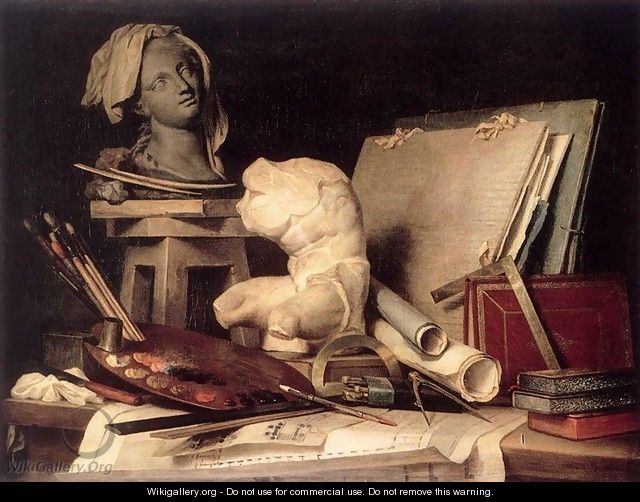Adelaide Labille-Guiard (1749-1803) was not only a gifted painter, but she was an important role model and teacher for women in the arts. The eighteenth century did not offer a friendly or conducive atmosphere for females to make a career out of being painters. Labille-Guiard not having come from an artistic family, took lessons in her adolescence with miniature painter Francoise-Elie Vincent, later apprenticed with pastel master, Maurice Quentin de la Tour, then studied under neoclassical painter Francois-Andre Vincent (son of her first teacher and whom she married in 1800). In 1774 she exhibited for the first time, a miniature painting and pastel with great success at The Academie of Saint-Luc's Salon (a rival guild and alternative to the French Royal Academy of Painting and Sculpture). Here she became a renowned teacher, which gave her the ability to open her own studio, to teach female pupils. In 1783, Labille-Guiard moved to a spacious apartment with several pupils on Rue de Richelieu in Paris. By this time she had taken on mentoring at least nine students:
• Mademoiselle Victoire d’Avril
• Mademoiselle Marie-Gabrielle Capet
• Mademoiselle Madeleine Frumpy
• Mademoiselle Rosemond (Mlle Carreaux de Rosemond)
• Mademoiselle Alexandre
• Mademoiselle Marie-Thérèse de Noiterre
• Mademoiselle Verrier (Mme Maillard)
• Mademoiselle Jeanne Bernard
• Mademoiselle P. Hubert
*********************************************************************************
Of the above nine pupils, Marie-Gabrielle Capet was the most well known.
Marie-Gabrielle Capet (1761-1817) was one of the pupils depicted in Labille-Guiard's famous "Self-Portrait with Two Pupils". She remained close to Labille-Guiard and her second husband Francois Andre-Vincent for all her years. The three worked in the same atelier until the end of Labille-Guiard's life. She became one of the most distinguished miniature painters of her day. It is suggested in the biography of Adelaide Labille-Guiard ("Une Emule d'Adelaide Labille Guiard" by A. Doria) that Capet switched to miniatures so as not compete with her mentor Labille-Guiard.


Marie-Gabrielle Capet, "The Atelier of Madame Vincent ", painting from 1808, now in the
Neue Pinakothek, Munich.
Madame Vincent is Adelaide-Labille Guiard--her name was adjusted after marriage to Francois-Andre Vincent.
Capet painted this after Labille-Guiard's demise, this painting shows Labille-Guiard painting Joseph-Marie Vien,
once a powerful director of the French Royal Academy in Rome, then later, Napoleon Bonaparte appointed him a
Senator.
Here is a link to a collection of miniatures by Capet :
http://www.pinterest.com/palettesandpear/the-miniatures-of-marie-gabrielle-capet/
As I researched Capet's miniatures, I was really struck by how lovely they were. These tiny jewels deserve a museum exhibit!
*********************************************************************************
Labille-Guiard became the first woman artist to be granted an apartment at the Palace of the Louvre. She requested an apartment from the arts ministry in 1785 but was refused. In 1792, her persistence for "the love of her art" finally paid off and she was granted the Louvre studio for herself and her pupils.
In 1791 Labille-Guiard petitioned the Academy to eliminate the"cap"of four being the maximum number of women allowed in the membership at one time. Since women members could not teach or hold office in the Academy, Labille-Guiard proposed that an unspecified number of women be admitted into the Royal Academy as "conseilleurs", an honorary title to which the privilege of exhibiting in the Salons was attached. The motion passed and women, although did not achieve the rank of Academicians, were given the more practical alternative, a chance to exhibit in the Royal Salon.
Labille-Guiard demonstrated her high aspirations as a woman in a time when it was against the odds to reach great heights for the female artist. She went from a miniaturist, to working in a grand scale in oils. "She was a feminist in both theory and in practice, opposing artificial barriers to the fulfillment of women's full potential and working to have those barriers removed. Every later woman artist owes Adelaide Labille-Guiard a debt of gratitude." (excerpt taken from page186 "Women Artists 1550-1950", by Ann Sutherland and Linda Nochlin)
****FACT: Women were not permitted to study at the French Royal Academy of Painting and Sculpture's classrooms or participate in their competitions. Although women could not receive an education at The Royal Academy, they did permit a VERY limited number of females as members. Immediate membership was granted to women, bypassing the "normal" requirements and training given by the Royal Academy to male prospective members. When Adelaide Labille-Guiard was admitted to the Royal Academy in 1783, the maximum number of women allowed was four. A rival guild-- though not as prestigious as the Royal Academy-- The Academie de Saint-Luc, was much more accepting of women, its number of women members totaled 130 by 1777.****
**Many thanks to the National Museum of Women in the Arts, for assisting me with factual research on Adelaide Labille-Guiard. Here is a link to their website http://www.nmwa.org**








,_1881.jpg)


























